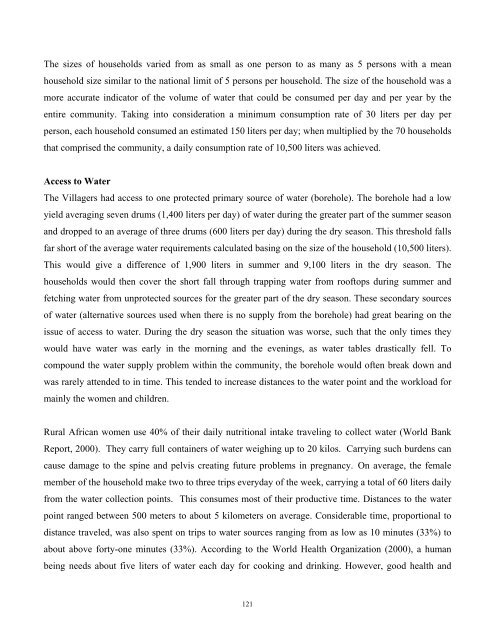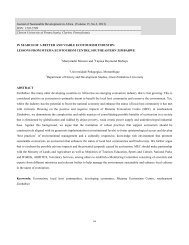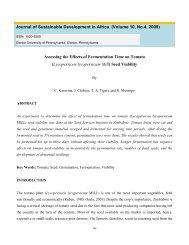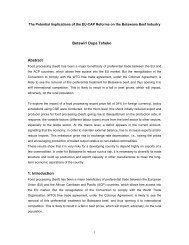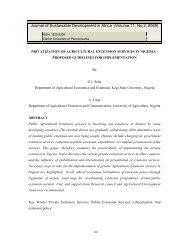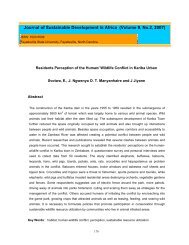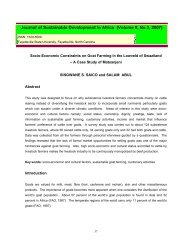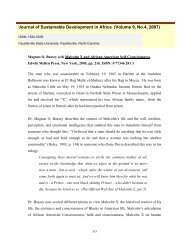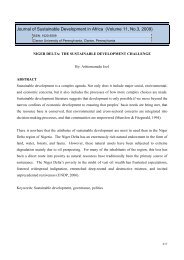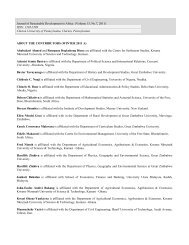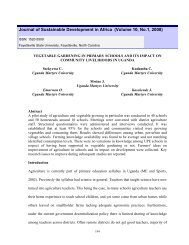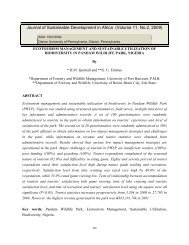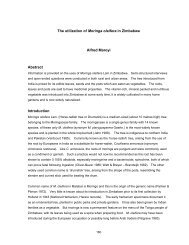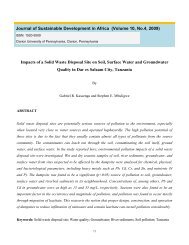Access to Safe Drinking Water by Rural Communities in Zimbabwe
Access to Safe Drinking Water by Rural Communities in Zimbabwe
Access to Safe Drinking Water by Rural Communities in Zimbabwe
Create successful ePaper yourself
Turn your PDF publications into a flip-book with our unique Google optimized e-Paper software.
The sizes of households varied from as small as one person <strong>to</strong> as many as 5 persons with a mean<br />
household size similar <strong>to</strong> the national limit of 5 persons per household. The size of the household was a<br />
more accurate <strong>in</strong>dica<strong>to</strong>r of the volume of water that could be consumed per day and per year <strong>by</strong> the<br />
entire community. Tak<strong>in</strong>g <strong>in</strong><strong>to</strong> consideration a m<strong>in</strong>imum consumption rate of 30 liters per day per<br />
person, each household consumed an estimated 150 liters per day; when multiplied <strong>by</strong> the 70 households<br />
that comprised the community, a daily consumption rate of 10,500 liters was achieved.<br />
<strong>Access</strong> <strong>to</strong> <strong>Water</strong><br />
The Villagers had access <strong>to</strong> one protected primary source of water (borehole). The borehole had a low<br />
yield averag<strong>in</strong>g seven drums (1,400 liters per day) of water dur<strong>in</strong>g the greater part of the summer season<br />
and dropped <strong>to</strong> an average of three drums (600 liters per day) dur<strong>in</strong>g the dry season. This threshold falls<br />
far short of the average water requirements calculated bas<strong>in</strong>g on the size of the household (10,500 liters).<br />
This would give a difference of 1,900 liters <strong>in</strong> summer and 9,100 liters <strong>in</strong> the dry season. The<br />
households would then cover the short fall through trapp<strong>in</strong>g water from roof<strong>to</strong>ps dur<strong>in</strong>g summer and<br />
fetch<strong>in</strong>g water from unprotected sources for the greater part of the dry season. These secondary sources<br />
of water (alternative sources used when there is no supply from the borehole) had great bear<strong>in</strong>g on the<br />
issue of access <strong>to</strong> water. Dur<strong>in</strong>g the dry season the situation was worse, such that the only times they<br />
would have water was early <strong>in</strong> the morn<strong>in</strong>g and the even<strong>in</strong>gs, as water tables drastically fell. To<br />
compound the water supply problem with<strong>in</strong> the community, the borehole would often break down and<br />
was rarely attended <strong>to</strong> <strong>in</strong> time. This tended <strong>to</strong> <strong>in</strong>crease distances <strong>to</strong> the water po<strong>in</strong>t and the workload for<br />
ma<strong>in</strong>ly the women and children.<br />
<strong>Rural</strong> African women use 40% of their daily nutritional <strong>in</strong>take travel<strong>in</strong>g <strong>to</strong> collect water (World Bank<br />
Report, 2000). They carry full conta<strong>in</strong>ers of water weigh<strong>in</strong>g up <strong>to</strong> 20 kilos. Carry<strong>in</strong>g such burdens can<br />
cause damage <strong>to</strong> the sp<strong>in</strong>e and pelvis creat<strong>in</strong>g future problems <strong>in</strong> pregnancy. On average, the female<br />
member of the household make two <strong>to</strong> three trips everyday of the week, carry<strong>in</strong>g a <strong>to</strong>tal of 60 liters daily<br />
from the water collection po<strong>in</strong>ts. This consumes most of their productive time. Distances <strong>to</strong> the water<br />
po<strong>in</strong>t ranged between 500 meters <strong>to</strong> about 5 kilometers on average. Considerable time, proportional <strong>to</strong><br />
distance traveled, was also spent on trips <strong>to</strong> water sources rang<strong>in</strong>g from as low as 10 m<strong>in</strong>utes (33%) <strong>to</strong><br />
about above forty-one m<strong>in</strong>utes (33%). Accord<strong>in</strong>g <strong>to</strong> the World Health Organization (2000), a human<br />
be<strong>in</strong>g needs about five liters of water each day for cook<strong>in</strong>g and dr<strong>in</strong>k<strong>in</strong>g. However, good health and<br />
121


